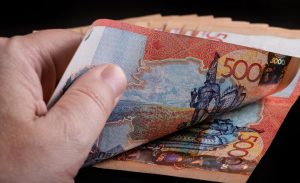Central Asia is emerging as one of the most attractive destinations for financial flows from the Middle East. According to Arab News, investments from Gulf Cooperation Council (GCC) countries in Central Asia have nearly tripled since 2022. Financial cooperation is also expanding through Islamic finance: the Islamic Development Bank (IsDB) has invested $9.1 billion across CIS countries, with around 60 percent directed to Central Asia. This growing involvement has the potential to reshape the region’s financial landscape and accelerate modernization.
Among the most active players is the United Arab Emirates. First Abu Dhabi Bank (FAB), the UAE’s largest lender, has become a key arranger of a green loan for Uzbekistan’s Zarafshan Wind Power Project, a 500-megawatt facility – the largest renewable energy project in Central Asia. In 2025, the Eurasian Development Bank (EDB), headquartered in Almaty, placed 200 million dirham (approximately $54 million) in bonds on the Abu Dhabi Securities Exchange with FAB’s support, opening a new liquidity channel between Central Asian issuers and Gulf capital markets.
Saudi Arabia is pursuing a similar path through development and export finance. The Saudi Export-Import Bank (EXIM) has strengthened cooperation with Kazakhstan’s Development Bank and signed a memorandum with Tajikistan’s State Unitary Bank (AFESD) to expand access to Saudi exports. Through the Saudi Fund for Development (SFD), Riyadh has extended concessional loans, including $30 million to Tajikistan for the construction of the Kulob Ring Road. The IsDB, headquartered in Jeddah and with Saudi Arabia as its largest shareholder, continues to finance key projects in energy, transport, and agriculture throughout the region.
Qatar, meanwhile, is steadily increasing its financial footprint. In 2024, the Qatari Lesha Bank acquired Kazakhstan’s Bereke Bank JSC for 65 billion Kazakh tenge ($134 million) – marking the first full acquisition of a Central Asian bank by a Gulf investor. The Qatar Fund for Development (QFFD) allocated $50 million to Tajikistan for the Rogun Hydropower Project and announced plans to participate in gas processing and hydropower ventures in Kazakhstan and Turkmenistan.
During the Astana Forum 2025, Qatar’s Power International Holding (PIH) – a diversified conglomerate operating in more than 19 countries – declared its intention to expand in Kazakhstan through long-term investments in energy, infrastructure, and digital transformation. PIH is involved in building two gas processing plants with capacities of 1 and 2.5 billion cubic meters per year, as well as developing two major gas pipelines – Aktobe-Kostanay and Beineu-Bozoy-Shymkent. The company also acquired mobile operators Altel and Tele2, with plans to modernize Kazakhstan’s digital infrastructure and ensure equitable access to high-speed internet.
The growing activity of Gulf banks in Central Asia reflects a dual motive – to diversify beyond oil economies and to respond to Central Asia’s demand for long-term investment in the Middle Corridor, or Trans-Caspian International Transport Route, which connects Asia to Europe via the Caspian Sea and the Caucasus. This corridor is viewed as faster and more efficient than traditional transit routes. At the same time, the rise of FAB, Saudi EXIM, SFD, QFFD, and PIH illustrates a new financial vector linking the Persian Gulf and Eurasia. These dynamics unfold alongside major Chinese and U.S. investments in energy, logistics, and industry – a combination that further motivates GCC states to deepen their presence in Central Asia to balance influence and diversify partnerships.
A key institutional link in this emerging financial geography is the Astana International Financial Center (AIFC), established in 2018. The AIFC has simplified interaction between Gulf markets and those of Central Asia, the Caucasus, the Eurasian Economic Union, and western China. Operating under a special legal regime based on English common law, it offers an investor-friendly environment with English as its official language and a modern infrastructure for dispute resolution and Islamic finance.
Experts also highlight the rise of Islamic banking as a distinct trend. According to Fitch Ratings, the volume of Islamic financial products in Central Asia exceeded $500 million by the end of 2024. In Kyrgyzstan, Islamic “windows” within commercial banks are expanding faster than traditional sectors, while Kazakhstan and Uzbekistan are building legal frameworks for Shariah-compliant loans and bonds. For Gulf banks, this is a natural niche: they possess both expertise and infrastructure to develop sukuk (Shariah-compliant bonds) and Islamic credit instruments that could support local economies in a culturally compatible way.
However, the expansion of Gulf financial activity also faces challenges. Most current projects remain tied to large-scale financing and bond placements rather than retail or SME banking. Regulatory fragmentation remains a major barrier: each Central Asian country maintains its own banking and currency rules, complicating cross-border credit and capital flows. Limited market transparency, weak investor protection, and underdeveloped capital markets further constrain deeper integration. Without sufficient domestic infrastructure, many issuers cannot access exchanges in Abu Dhabi, Doha, or Riyadh directly.
Nonetheless, the overall trend is clear: the financial map of Central Asia is changing. Over the coming years, one can expect the expansion of Islamic banking services, new financial products for businesses and individuals, and more Central Asian issuers entering Gulf capital markets. The success of this transformation will depend on how quickly regional governments can strengthen regulatory frameworks, improve transparency, and enhance investor confidence.
If these reforms take root, Gulf banks will increasingly enter the region not only as lenders but as strategic partners in modernizing its financial infrastructure. Pioneering institutions such as FAB from the UAE, Saudi EXIM and SFD from Saudi Arabia, and Lesha Bank and QFFD from Qatar already demonstrate that this cooperation extends beyond project financing – it is about building bridges for sustained capital flow into logistics, energy, and industrial sectors.
For now, the Gulf banks’ expansion has not yet reshaped retail banking in Central Asia, but it has already become a defining factor in redistributing regional financial flows, accelerating modernization, and intensifying competition for major investment projects. As Central Asia continues to integrate into global capital markets, these new partnerships with the Arab world may well prove to be one of the region’s most important strategic realignments of the decade.





























